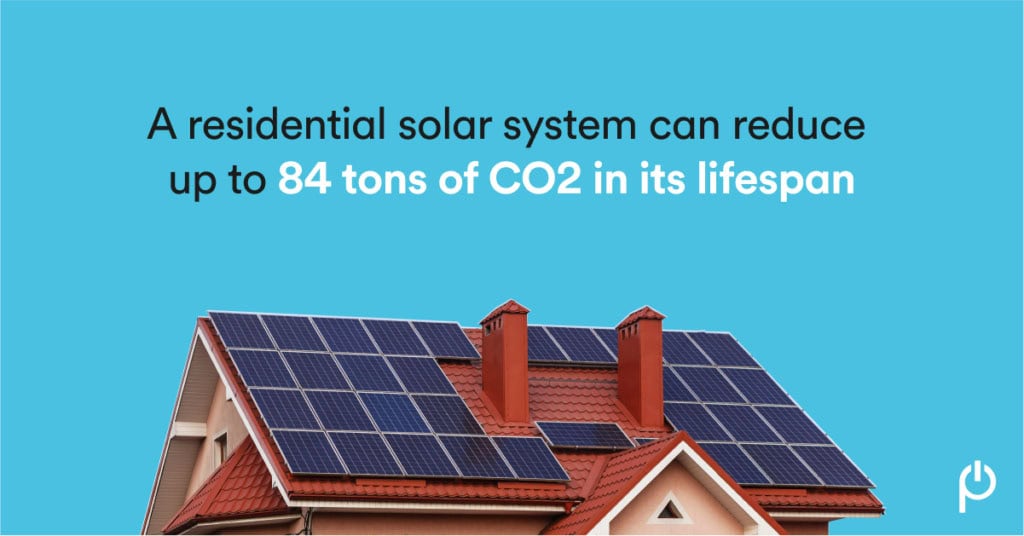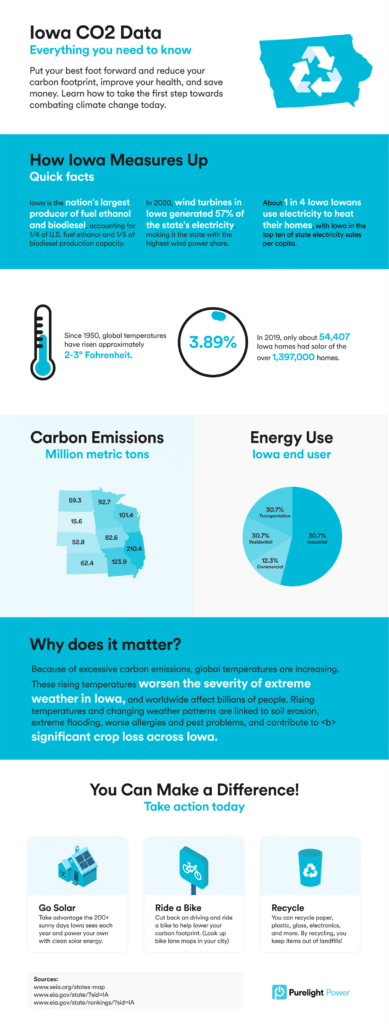Are you familiar with the term “carbon footprint”? If not, it might be time to learn what a carbon footprint is.
In the Hawkeye State, Iowans produced approximately 76 million metric tons of CO2 (carbon dioxide) in 2017, according to the most recent data from the US Energy Information Administration.
Despite being the leading state in the nation for green energy, Iowa is right smack in the middle of state carbon emissions rankings.
We can all help keep Iowa in the lead of the nation-wide transition to greener energy by making decisions that reduce the amount of CO2 emissions caused by our everyday choices. Many of these changes are simple and quick to implement, so you can get started today!
Continue reading to learn everything you need to know about lowering your carbon footprint and being part of Iowa’s move to a more sustainable future.
Carbon Footprint: What Is It?
A “carbon footprint” is a measurement that refers to total carbon dioxide (CO2) emissions like from an event, organization, type of vehicle, building location, industrial activity, or the daily choices for everything from transportation to eating that an individual makes.
Activities such as burning fossil fuels, clearing land, and manufacturing or using food or industrial goods all contribute to the release of greenhouse gases such as carbon dioxide and methane.
While companies produce more CO2 than individuals, we all have an impact.
The average American’s carbon footprint is 16 tons, making it one of the world’s highest compared to the global average of 4 tons in other countries around the world.
If we want to address the looming threat of climate change, we must work together to reduce the most severe effects on weather extremes, ecosystems, human health, and infrastructure, while also slowing down global warming.
Think reducing your carbon footprint will be too hard?
Even the simplest changes like eating less meat each week, hanging some of your clothes to dry, or taking public transport a few days a week can make a noticeable dent in your carbon footprint.
Why Should Iowa Residents Care About Their Carbon Footprint?
With an 8% increase in precipitation from 1873 to 2008, Iowa has already felt the effects of climate change, including increased and more frequent intense storms which destroy key agricultural crops and homes across the state.
But how do these changes connect to carbon emissions?
When CO2 is released into the atmosphere, it absorbs sunlight and retains the heat that it absorbs. As a result, weather patterns are disrupted, and global temperatures rise, causing climate changes that can have serious and deadly results.
We only have one planet to live on, and it’s our duty to protect and preserve it for the benefit of not just ourselves, but future generations of Hawkeye fans. The amount of waste and resources can be reduced by all of us working together.
How Can Iowans Reduce Their Carbon Footprints?
The two most common ways Americans contribute to global warming are driving a car and heating their homes.
Aside from these two major contributors to greenhouse gas emissions, lifestyle choices such as the food we eat, and where we buy our clothes, home goods, and electronics all contribute to our carbon footprint.
Fortunately, you can make a difference right now. In the following sections, we will show you how you can make a difference by making a minor adjustment to a few of the things you do every single day.
Every good habit begins with one step and grows over time!
1. Switch to Cleaner Home Energy
If you live in Iowa, you might assume that your electricity is generated using relatively clean energy from the wind farms popping up around the state. Unfortunately, that’s not the case for the majority of the electricity used in the state.
Iowa is still dependent on coal and natural gas-fired electric power plants for the majority of its energy needs.
This doesn’t mean homeowners in Iowa have to rely on this dirty electricity to power their homes. With Iowa already the leading nation in renewable energy, many homeowners have made the switch to clean, solar energy generated right on their own roofs.
With Purelight Power’s zero down program, and the federal tax credit that reimburses the homeowner for up to 26% of the cost of their solar energy system, thousands more homeowners can now afford clean clean solar energy at home.
As an added benefit of having a solar energy system installed on your home, you’ll be eligible for Iowa’s legally guaranteed net metering. Why not produce your own energy and avoid paying an ever-rising utility bill that increases 4% each year on average.
2. Rethink How You Get Around
The majority of human-produced emissions in Iowa are a result of transportation, specifically from trucks and cars. To put things in perspective, transportation is responsible for nearly 15% of all emissions in Iowa. This may not seem like a lot, but it’s the equivalent of 20 million metric tons of CO2.
The good news is that across the country, Americans are taking action and setting realistic goals, like requiring zero emissions in all new vehicles by 2035 for all vehicle manufacturers. In fact, Ford and Dodge, American pioneers in the automotive industry, are among the many manufacturers switching to electric vehicles.
Of course, not everyone has the financial means to buy an electric car. Luckily, there are plenty of other ways to reduce your transportation-related carbon emissions.
Beyond accessible public transport, Des Moines is a hub for bike paths with an extensive trail system of 68 miles of paved trails, and 19 miles of soft trails.
Other cities throughout Iowa also have an abundance of biking and walking trails, making physical activity a more attractive mode of transportation.
Working to lower your carbon emissions is more than just good for the environment, it’s good for you too. Get out. Get Active. Go Green!
3. Focus on the Reuse of Reduce – Reuse- Recycle
Rather than tossing items that are no longer in use, finding creative ways to repurpose them, like reusing a glass jar as a flower vase, is an easy and cost-effective way to reduce CO2 emissions.
With landfills in the US producing 114.5 million metric tons every year, throwing away less is a key way to reduce your carbon footprint.
For items you can’t personally re-use, rather than tossing, consider donating via your local donation center or through your neighborhood’s Buy Nothing or Freecycle group. One person’s trash really can be another person’s treasure.
Some other options for reducing new items and instead going with new-to-you which will reduce your carbon footprint are:
- Thrift store shopping for clothes and household goods
- Using recyclable containers and bags in place of single-use plastic ones
- Sharing items with neighbors through FreeCycle and Buy Nothing Groups on social media
- Composting at home, which allows you to recycle food waste while also providing your garden with rich, healthy soil
4. Shop Local
How frequently do you buy something from Amazon or another online retailer?
Your items may arrive within a day or two, but they are manufactured in countries outside of the U.S., and are traveling long distances to get to you. Every time you make a purchase and have it shipped to your home, you indirectly contribute to the release of CO2 into our atmosphere from the fuel used to produce and transport those goods.
Try shopping locally instead!
In Iowa we’re lucky to have an abundance of farmers markets brimming with local vendors who grow, build, and craft all of their products from locally sourced materials. If you’re not sure if there are any farmers markets in your area, the Iowa Department of Agriculture has a list.
For added impact, ride your bike to the market and bring your own reusable shopping bags and containers to store your purchases.
By shopping locally, you are not helping reduce carbon emissions, but you are also putting money back into your community.

Join Iowa in reducing CO2 emissions
Iowans can’t afford to ignore the mounting evidence of global warming and climate change. The State of Iowa is already taking steps to reduce carbon emissions at the state level in an effort to mitigate the negative effects of climate change.
At the local level, we’re seeing this change too. The Des Moines City Council is moving forward with a resolution that establishes a timeline for several milestones in the transition from fossil fuels to renewable energy sources such as wind and solar power.
The city initially set an ambitious goal of reducing emissions by 45% between 2010 and 2030 but knocked that percentage out of the park when they reduced emissions by 49% in just 9 years.
The other part of this plan includes reaching net-zero emissions by 2050. At this rate, we’ll have no problem reaching this goal in Iowa. However, it’s important we don’t get complacent with this early accomplishment.
Solar Power Savings for Iowa Homeowners
Switching to solar energy can save American homeowners a significant amount of money while also lowering their carbon footprint.
Iowa residents can go solar with no money down and no out-of-pocket expenses thanks to Purelight Power, the leading Iowa solar expert.
By switching to solar you can actually pay less per month on your solar system than you do on your utility bill. And once your system is paid off in full, you own your power just like you would a house.
No more renting dirty energy from MidAmerican.

Cut your Carbon with Solar Power
Going solar at home is more affordable than ever. Iowans who make the switch to clean solar energy start saving their very first month!
Find out how much you can save by making the switch to solar today with a quick 30 second quiz!





